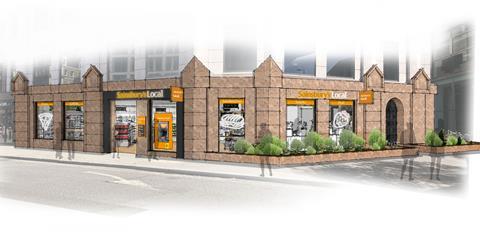“I wouldn’t consider this to be a plan B”, Sainsbury’s boss Mike Coupe said as he lifted the lid on the grocer’s strategic update today.
“Tweaks” rather than transformation were certainly the order of the day as Coupe and his senior leadership team sought to restore confidence in the City, having presided over a tumbling share price during the past 12 months.
There’s no escaping the fact that pressure has been mounting on Coupe to unveil his vision for how to get Sainsbury’s back on track, following the collapse of its proposed merger with Asda earlier this year.

That blocked deal was imperative, the grocer had argued vehemently last year, if it was to better compete in a rapidly changing grocery market and invest in cutting prices for consumers.
But the Sainsbury’s chief executive will now rely on strategic evolution rather than revolution in his bid to adapt.
“What we’ve been talking about today is a continuation of a strategy that we’ve been working towards for five years, but there are a few tweaks along the way,” Coupe says.
Chief among those tweaks outlined at a capital markets day in Southampton are some much-trailed changes at Sainsbury’s financial services business. Sainsbury’s Bank has immediately stopped offering mortgages and the group will pull the plug on capital investment into its banking arm at the end of the current financial year.
That will allow it to increase focus on its core retail business. Coupe insists Sainsbury’s has some “exciting” initiatives in place to get it firing on all cylinders once again.
So, how does he plan to breathe fresh life into the food and general merchandise giant – and will they bring the rewards that customers and shareholders want?
Cutting costs
Sainsbury’s has already stripped hundreds of millions of pounds out of its cost base since the Argos acquisition, but is now targeting a further £500m in savings – the same sum it said the Asda merger would deliver – over the next five years.
Finance boss Kevin O’Byrne says such cuts are necessary if Sainsbury’s is to “invest in some of the improvements” required across the business.
Much of that half-a-billion-pound pot will be delivered by bringing the Sainsbury’s and Argos businesses even closer together, by reducing a £5bn bill of what it calls “addressable costs”.
Although the retailer would not be drawn on specific detail on the 15 programmes it is targeting for savings, O’Byrne provides a couple of examples of low-hanging fruit to go at.

He says Sainsbury’s and Argos currently operate a total of 12 data centres, but “won’t need” all of those as its teams and locations continue to come together. Technology functions will also be brought together in a similar way.
In logistics, the two fascias have independent fleets of trucks, but they will start to buy vehicles together and better use the space in them when making deliveries.
And the group is eyeing savings on rent and business rates as it shutters more Argos standalone stores and replaces them with shop-in-shops inside Sainsbury’s larger supermarkets. It expects to close between 60 and 70 Argos branches over the next five years, replacing them with up to 80 in-store implants.
Sainsbury’s broader store closure programme, which will also involve taking the axe to 15 underperforming supermarkets and 40 convenience stores, will alone deliver a £20m uplift in annual operating profit.
Coupe is tight-lipped on how many jobs could be impacted by the changes, but insists Sainsbury’s has a “strong track record” when it comes to Argos, in particular. The general merchandise business employs more staff now than it did prior to its acquisition by Sainsbury’s three years ago.
Many of the new Argos shop-in-shops will be relocations, situated near to the standalone stores earmarked for closure. That will allow Sainsbury’s to redeploy staff without making redundancies.
Stepping up in-store
Although it is shutting a clutch of stores – up to 125 in total across the group – following a review of its portfolio, Sainsbury’s also plans to pump cash back into its estate.
The grocer wants to open 10 new supermarkets and 100 convenience shops between now and 2024/25. The latter tranche of openings will include two new formats, details of which Sainsbury’s unveiled today.
The first is what it calls a “large convenience store”, which will include Argos concessions and other services such as pharmacies or opticians, alongside the food offer. Sainsbury’s has quietly opened two of the stores, in Ascot, Berkshire, and Woodhall Spa, Lincolnshire, in recent weeks.
It is also eyeing ‘Food on the Move’ stores, focusing on city-centre locations such as Manchester and Birmingham, and will increase its breakfast and lunch options for time-pressured customers looking for quick meal solutions. The first of those will launch in London’s Mansion House “shortly”, O’Byrne says.
Sainsbury’s is also taking new ideas into its existing estate. It presented its strategic plan to analysts from its supermarket in Hedge End, Southampton, which has just been radically revamped to fit its latest big-box thinking.
Building on its Selly Oak “experiment”, Hedge End devotes more space to clothing and general merchandise, with furniture and homeware products from Sainsbury’s Home, Argos and Habitat showcased together in mock room layouts. A new ‘Fresh Kitchen’ café has been refitted and expanded, revamped beauty aisles have been installed and concession partners Timpson, Lloyds Pharmacy, Specsavers and Sushi Gourmet introduced.
Owning own-brand
Within that broader mix, Sainsbury’s own-label grocery proposition is being pushed towards centre stage once again.
In its entry-level tier, in particular, Sainsbury’s had been left behind by the discounters, Aldi and Lidl, and Tesco, which launched a stable of ‘Exclusively at Tesco’ brands across fruit, vegetables, meat, poultry, fish and ambient.

Sainsbury’s food commercial director Paul Mills-Hicks admits Sainsbury’s entry-level Basics brand “wasn’t quite doing the job that we wanted it to do”.
It is in the process of rolling out 13 brands to give the range “much more compelling credit for the products and the quality and value that they offer”.
The grocer has introduced 12 of those brands – and 120 products – to stores already. By the end of the year, the 13th brand will be available in stores and its new-look entry-level proposition expanded to more than 200 products.
Mills-Hicks admits Sainsbury’s “had a good look” at what Tesco had achieved with its entry-level ranges before launching its new brands, but insists it was “very careful” with its approach not to create a “me too” stable of products.
He took a swipe at its great grocery rival, saying Sainsbury’s leant on its heritage to come up with brand names, such as its J. James & Family breaded chicken products, rather than introducing the sort of “made up” labels that drew controversy when Tesco launched its Farm brands.
Sainsbury’s says it has stemmed the loss of customers to the discounters over the past year and believes the revamped entry-level ranges will help it bring one or two items back into its baskets.
Digital drive
Sainsbury’s harnessed its Nectar loyalty scheme to help it relaunch own-label ranges, but that is just one way it is using data and digital to transform its business.
Digital – spanning online shopping to the Nectar loyalty programme – now accounts for a fifth of the group’s sales. Customers who shop online are “more engaged”, “spend the most” and are “the most loyal”, according to chief information officer Phil Jordan.
A customer who shops online and offline with Sainsbury’s spends an average of 2.4 times more than those who only shop in store, Jordan reveals, while those who engage “more extensively” online across Argos and Habitat spend 3.1 times more, Jordan says.
As a result, Sainsbury’s is stepping up efforts to put digital at the heart of its business.

The Nectar app, replacing a plastic card and paper coupons, will be rolled out nationally in the next few weeks following trials in the Isle of Wight and Wales.
SmartShop scan-as-you-shop technology is live in 50 supermarkets and will be rolled out more widely. Customers who use SmartShop spend 18% more than those who do not.
Jordan says Sainsbury’s has changed the way it builds such tech-led applications – making them “lighter” and cloud-based to improve performance.
He says Sainsbury’s is now “well placed to leverage these assets in a much more multi-brand, multichannel way”.
Over the next year, the business plans to roll out voice search on Amazon Echo and Google Home, which will return relevant search results from its Sainsbury’s, Argos and Habitat propositions. The change would allow shoppers to build one online basket, containing products from across all three brands.
It wants to use digital to create more “personalised” in-store shopping. Sainsbury’s customers will soon be able to scan a product using their smartphone, and receive information on the location and availability of that product in-store, as well as nutritional information about the product.
Future fitness
After a turbulent 12 months, Coupe is “confident” such strategic “tweaks” will make Sainsbury’s fitter for the multichannel future.
“We believe that we are in great shape now to deliver some pretty significant changes in the way that we interact with our customers over the next period,” he says.
The financial markets would appear to agree. Sainsbury’s share price has rallied 2% since this morning to 217.3p at the time of writing.
It marks the first step in Coupe’s journey to rebuild momentum and return to Sainsbury’s to the peak of its powers.


























No comments yet